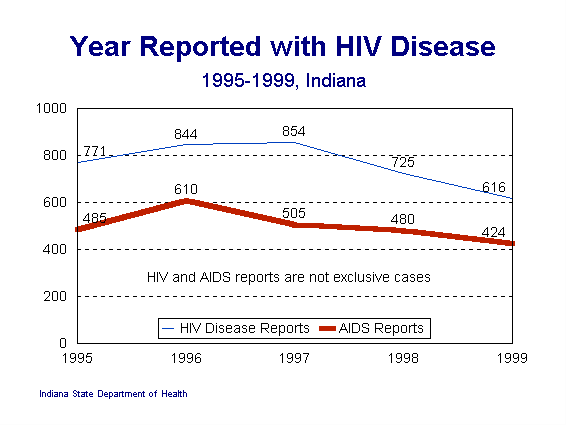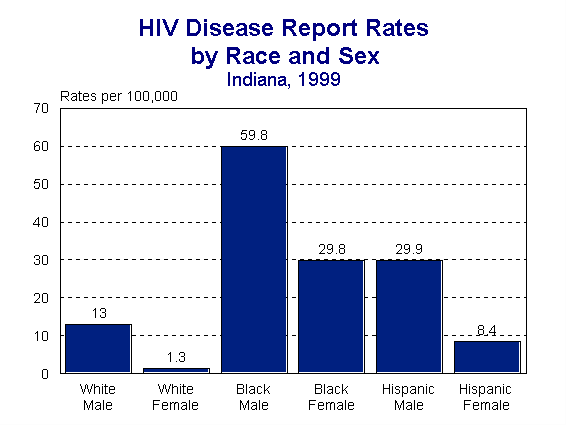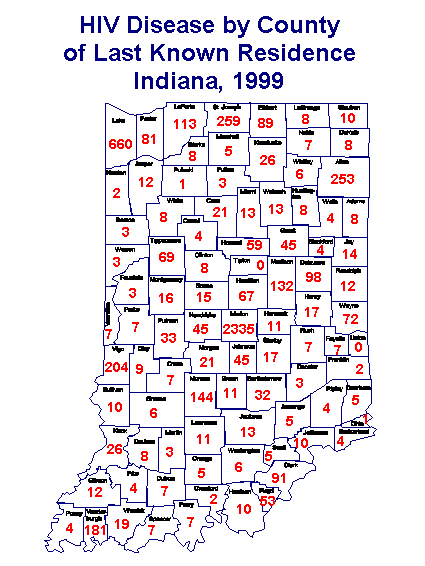
HIV Disease
(Acquired Immune Deficiency syndrome (AIDS)
and Human Immunodeficiency Virus (HIV))
|
Rates per 100,000 population December 31, 1998 |
|||
|
Cases |
Rate per |
|
|
AIDS cases reported |
|||
|
5,709 |
|
|
|
356 |
|
|
|
Crude AIDS point prevalence rate: |
|||
|
2,443 |
41.4 |
|
|
Sex-specific AIDS point prevalence rate: |
|||
|
286 |
9.4 |
|
|
2,157 |
75.1 |
|
|
Race-specific AIDS point prevalence rate: |
|||
|
White |
1,673 |
32.1 |
|
|
Black |
668 |
136.2 |
|
|
HIV-infected cases reported: |
|||
|
Cumulative |
3,301 |
||
|
1999 |
299 |
||
|
Crude HIV point prevalence rate: |
|||
|
3,114 |
52.8 |
|
|
Sex-specific HIV point prevalence rate: |
|||
|
Female |
563 |
18.6 |
|
|
Male |
2,551 |
88.9 |
|
|
Race-specific HIV point prevalence rate: |
|||
|
White |
1,871 |
35.9 |
|
|
Black |
1,104 |
225.0 |
|
|
Crude HIV Disease Rate (HIV and AIDS): |
94.22 |
||
The number of HIV infection and AIDS diagnoses (HIV Disease) has decreased for the last several years. The number of new HIV infections may be declining due to changes in behaviors that put people at risk for contracting HIV Disease. The number of AIDS diagnoses has declined due to new medications and combinations of medications that mediate the severe impact on the immune system. Figure 1 includes HIV/AIDS reports of infected persons who have moved to Indiana with disease.
Figure 1.

Number of AIDS Cases Reported
The number of AIDS cases reported in 1999 decreased from the number reported in 1998 in Indiana (Table 1). The number of AIDS cases reported in the United States in 1999 was less than the number reported in 1998 also. The decrease in reported AIDS cases does not necessarily indicate a decrease in HIV infection diagnoses in 1999, but does demonstrate the effect of medications that are preventing or delaying severe immunosuppression (AIDS). Of the AIDS cases reported in 1999, 239 (50%) were diagnosed in 1999. The remaining cases were diagnosed from 1984 to 1997 and reported first in 1998.
|
Table 1. |
|||||
|
1995 |
1996 |
1997 |
1998 |
1999 |
|
|
Indiana |
485 |
610 |
505 |
480 |
424 |
|
US |
73,767 |
69,151 |
60,634 |
48,269 |
46,400 |
Of those diagnosed with AIDS in 1999, 261 (54%) were initially diagnosed as AIDS due to the suppression of the CD4 below 200/mm3. Of those reported with AIDS in 1999, 194 (39%) were diagnosed with AIDS at the same time that they were first diagnosed as being infected with HIV. Fifty-six percent (269) were diagnosed with AIDS within two months of being identified as infected with HIV. These people did not know they were infected with HIV until they became symptomatic with AIDS. They were not receiving medical care prior to becoming severely immunosuppressed.
Persons Living with HIV Disease
The number of people reported as living with HIV Disease (HIV infections and AIDS) continues to increase (Table 2). During 1999, there were 6,085 persons living with HIV Disease in Indiana. This includes those that were residents of Indiana when first diagnosed and those that have moved to Indiana since they were diagnosed. The number of reported cases does not account for all of the people living with HIV Disease. In addition to the over 6,000 people that have been diagnosed and reported, there are others who have tested positive for HIV, but are not receiving health care services. In addition, there are those who are infected, but do not know their HIV status. Indication of both of these facts is found in the number of people who are reported years after their initial diagnosis and the number of people who were diagnosed with severe immunosuppression at, or near, the same time they were diagnosed as being infected.
|
Table 2. Persons Living With HIV Disease in Indiana, 1994-1997 |
||
|
Year |
Total Number Living |
Increase |
|
1995 |
4,496 |
294 |
|
1996 |
4,954 |
458 |
|
1997 |
5,557 |
603 |
|
1998 |
6,085 |
528 |
|
1999 |
6,171 |
86 |
Pediatric HIV Disease and Exposure to HIV
Pediatric HIV and AIDS cases are included in the cases reported above. However, there are additional children and families impacted by HIV infection even without a diagnosis of HIV Disease. By the end of 1999, there had been 261 children born to women in Indiana who had HIV Disease. The diagnostic status of these children at the end of 1999 is summarized in Table 3.
|
Table 3. |
|
|
Diagnostic Category |
Children |
|
Exposed: born to a woman who is HIV positive, but testing has not yet determined child's HIV status, or the child was lost to follow-up before HIV status was determined |
66 |
|
HIV Infected: HIV positive by laboratory testing |
33 |
|
AIDS: meets case definition for pediatric AIDS |
34 |
|
Definitely Not Infected (DNI): mother is HIV positive, but child is HIV negative based on laboratory tests |
128 |
|
Total |
261 |
HIV Counseling and Testing
HIV counseling and testing (CT) is available in Indiana, either free of charge or for a nominal fee. CT sites are located throughout the state. The percentage of HIV positive clients decreased again in 1999 to less than 1% (0.95%). This represents 239 HIV infected people. The positivity rate for those tested under the anonymous protocol was 1.46% (92 of 6,295) and for those tested confidentially it was 0.74% (146 or 19,679). Of the positive test results 103(43%) were done with people who had previously tested positive (repeating a positive test). There were 11,474 tests done with people who had previously tested negative.
|
Table 4. |
||||
|
Year |
Number |
Number |
Number Positive |
Percent |
|
1995 |
149 |
31,608 |
446 |
1.4 |
|
1996 |
154 |
28,937 |
317 |
1.1 |
|
1997 |
154 |
24,835 |
318 |
1.3 |
|
1998 |
159 |
24,348 |
239 |
1.0 |
|
1999 |
218 |
24,956 |
239 |
0.95 |
The percentage of tests that were done confidentially increased again in 1999 to 75% (Table 5). Anonymous testing is also available at Counseling and Testing sites. Private providers cannot test anonymously. Persons tested anonymously are not able to document their HIV status and therefore cannot access follow-up medical, social, or mental health services. Many counseling and testing sites also offer tuberculosis testing and immune function testing by CD4 count to those who test positive for the HIV. The CT sites also offered syphilis testing during 1999 because of the increase in syphilis in Indiana. Hepatitis B vaccines are also available at many sites. CT sites also refer clients for medical care, social services, and HIV care coordination. Other resources available at CT sites are mental health care, housing advice, and legal services by referral to care coordination.
|
Table 5. |
||
|
Year |
%Anonymous |
%Confidential |
|
1995 |
35 |
65 |
|
1996 |
33 |
67 |
|
1997 |
28 |
72 |
|
1998 |
26 |
74 |
|
1999 |
25 |
75 |
Although CT clients are self-selected, the demographic distribution of CT clients with positive tests for HIV is similar to that of cases reported by sources other than CT.
Demographics
Age
Demographic patterns of HIV Disease in Indiana continue to change slowly (Table 6). The age at which HIV is first diagnosed is highest in the 30-39 age group. The same is true of AIDS diagnoses. Given that most people are not tested for the HIV at the inception of the infection, the number of persons in their twenties testing positive indicates that a high proportion of these persons were probably infected during adolescence. The age distribution of AIDS cases in Indiana mirrors that of the nation as a whole. The largest age group to be tested at CT sites is 20-29 (42% of all tests). The age group with the highest percentage of positive HIV tests is 20-29 years old (42% of all positive tests). This is a change from 1998 when the largest age group with positive test results was 30-39 years old.
|
Table 6. |
|||||
|
Age |
HIV |
AIDS |
|||
|
No. |
% |
No. |
% |
||
|
0-12 |
7 |
1 |
3 |
1 |
|
|
13-19 |
14 |
4 |
4 |
1 |
|
|
20-29 |
111 |
31 |
79 |
19 |
|
|
30-39 |
139 |
39 |
187 |
44 |
|
|
40-49 |
70 |
19 |
105 |
25 |
|
|
>49 |
19 |
5 |
46 |
11 |
|
|
Total |
360 |
424 |
|||
|
|
|||||
Figure 2.

Gender
Males continue to be the sex more affected by HIV Disease in Indiana (Table 7). However, the proportion of female HIV cases continues to be higher than that for AIDS among females. In 1999, females comprised 13% of all reported AIDS cases in Indiana, and 24% of all reported HIV cases. The larger proportion of females reported with HIV infection indicates a more rapid increase in HIV Disease among women than among men.
|
Table 7. |
||||
|
Gender |
HIV |
AIDS |
||
|
No. |
% |
No. |
% |
|
|
Males |
272 |
76 |
367 |
87 |
|
Females |
88 |
24 |
57 |
13 |
|
Total |
360 |
|
424 |
|
Race/Ethnicity
HIV Disease cases in Indiana have been predominately White, but the increasing incidence of HIV Disease among Blacks has now resulted in the Black incidence rate to surpass the White incidence rate. The number of Asian, Pacific Islanders, American Indians, and Alaskan Natives reported in Indiana are too small to be analyzed. Cumulatively, they are less than one percent of the reports.
In reporting the race/ethnicity of HIV Disease (Table 8), the White race is reported as White, non-Hispanic and the Black race is reported as Black, non-Hispanic. Hispanic ethnicity is reported as the person identifies themselves to health care professionals, or as the health care professionals believe the person to be. There is not comparable census data for the Hispanic ethnicity as it is reported for HIV Disease.
|
Table 8. |
|||
|
% of Indiana Population |
% of HIV Infection Case Reports |
% of AIDS Case Reports |
|
|
White |
90.6 |
53 |
63 |
|
Black |
8.5 |
40 |
33 |
|
Hispanic |
1.2 |
5 |
4 |
In Indiana, the race-specific rate of reported HIV Disease per 100,000 was 7.0 for Whites in 1999 (Table 9). For Blacks it was 43.8, and for Hispanics was 19.3. For race and sex-specific rates the distinctions are broader and point to the populations most impacted by HIV Disease (Figure 3). Black males and females both have much higher rates than their White or Hispanic counterparts.
|
Table 9. |
||
|
Race/Ethnicity and Gender |
Number |
Rate/100,000 |
|
White Male |
329 |
13 |
|
White Female |
35 |
1.3 |
|
Black Male |
139 |
59.8 |
|
Black Female |
77 |
29.8 |
|
Hispanic Male |
22 |
29.9 |
|
Hispanic Female |
6 |
8.4 |
Figure 3.

Mode of Transmission (Risk Factor or Risky Behavior)
For adults and adolescents in Indiana, the major risk factor remains men who have sex with other men (MSM). Although MSM was the most frequently reported risk factor in 1999 for persons reported with AIDS, it has declined from 60% in 1994 to 58% in 1999. For those reported as being infected with HIV, MSM was 51% of all reports. The apparent reduction among those reported with HIV infection should be tempered because 29% have not reported a risk factor by the end of 1999. (See Tables 10 and 11.)
|
Table 10. |
||||
|
HIV |
AIDS |
|||
|
No. |
Percent |
No. |
Percent |
|
|
MSM (men who have sex with men) |
155 |
49 |
192 |
54 |
|
IDU (injecting drug user) |
20 |
6 |
25 |
7 |
|
MDM & IDU |
10 |
3 |
12 |
3 |
|
Coagulation Disorder/ Treatment |
3 |
1 |
7 |
2 |
|
Heterosexual Contact with HIV+ person |
36 |
11 |
46 |
13 |
|
Transfusion/Transplant |
1 |
0 |
1 |
0 |
|
Not Reported |
90 |
29 |
70 |
20 |
|
Table 11. |
|||||
|
1995 |
1996 |
1997 |
1998 |
1999 |
|
|
MSM |
64 |
61 |
53 |
51 |
54 |
|
IDU |
11 |
12 |
14 |
13 |
8 |
|
MSM/IDU |
8 |
7 |
6 |
6 |
4 |
|
Coagulation |
0 |
1 |
0 |
1 |
2 |
|
Heterosexual |
7 |
10 |
13 |
11 |
13 |
|
Transfusion |
1 |
1 |
0 |
1 |
0 |
|
Not Reported |
9 |
8 |
14 |
17 |
20 |
It is typical for new reports to not contain a risk factor, especially HIV infection reports. The risk factors are reported later. If the risk factors were all identified the transmission pattern may be slightly different. (See Table 12.)
|
Table 12. |
|||
|
Risk Factor |
White |
Black |
Hispanic |
|
Male |
N=270 |
N=109 |
N=20 |
|
MSM |
59 |
30 |
46 |
|
IDU |
4 |
4 |
4 |
|
MSM/IDU |
3 |
3 |
0 |
|
Coagulation Disorder |
1 |
2 |
0 |
|
Heterosexual Contact |
5 |
5 |
8 |
|
Transfusion |
0 |
1 |
0 |
|
Not Reported |
17 |
19 |
19 |
|
Female |
N=31 |
N=63 |
N=6 |
|
IDU |
0 |
5 |
0 |
|
Heterosexual Contact |
6 |
10 |
15 |
|
Not Reported |
4 |
22 |
8 |
Transmission of HIV via blood components and whole blood has remained low in Indiana.
AIDS Related Deaths
There have been 3,987 deaths among people infected with the HIV. The number reported as dying in 1999 (87) is less than those reported as dying in 1998 (155). This is a change in the former pattern of more and more people dying each year with HIV. The change is due for the most part because of new medications that have been mediating the devastating effect of HIV on the immune system. With fewer people developing severely suppressed immune system there are also fewer opportunistic infections. The opportunistic infections were the cause of most of the deaths.
Figure 4 shows the number of people reported at diagnosis of HIV Disease by county of residence.
Figure 4.
